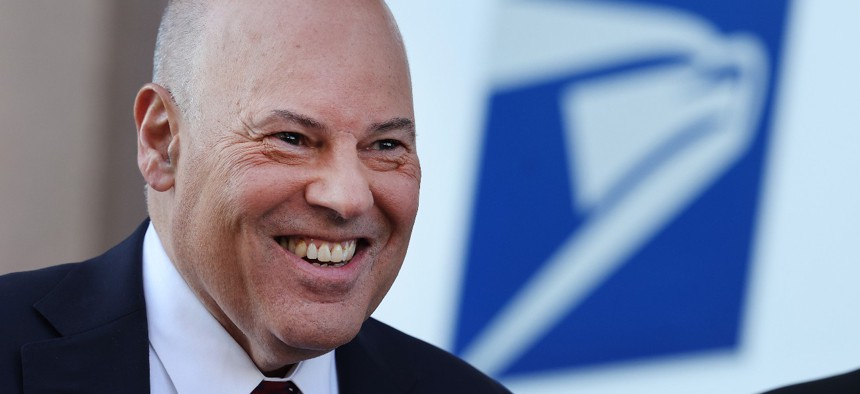
Postmaster General Louis DeJoy says his plan will still produce results. Kevin Dietsch/Getty Images
DeJoy Promises His USPS Plan Will Still Deliver, Despite Disappointing Numbers So Far
Two years into his plan, the postmaster general claims significant progress while conceding the agency has faced more obstacles than anticipated.
The head of the U.S. Postal Service is promising his overarching reform plan will soon turn around the mailing agency’s finances despite significant setbacks that have caused it to fall short of leadership’s ambitious goals.
USPS spent yet another quarter in the red, posting a net loss of $2.5 billion between Jan. 1 and March 31. The agency lost nearly $500 million when only accounting for costs within management’s control, compared to a net income of more than $400 million during the same period last year. Its revenue declined by nearly $500 million despite price hikes aimed at offsetting declining mail and package volumes.
Postmaster General Louis DeJoy, who spearheaded the Delivering for America plan he originally said would allow USPS to turn a profit in fiscal 2023 and would erase all the Postal Service’s accumulated and anticipated debts within 10 years, said his proposals would still deliver on their larger promise.
“We expect the next two years to be more exciting and consequential than the first—they need to be—and we will work diligently to fulfill the goals identified in the Delivering for America plan,” DeJoy said at a board of governors meeting on Tuesday.
After previously conceding USPS would fall short of its goal to get back into the black this fiscal year, he said at the meeting his agency was “not where we want to be.” Still, he noted the agency—primarily through the passage of the 2022 Postal Service Reform Act—has eliminated $90 billion from its $160 billion in projected 10-year losses. He blamed the shortfall on several factors, including inflation, ongoing overpayments into its pension accounts and a longer-than-expected effort to stabilize delivery times amid unusually pervasive delays. Roman Martinez, who chairs the board, also cited the Postal Service’s inability to invest its savings for retiree benefits into more aggressive and lucrative portfolios, noting a recent inspector general report that found such an approach could more than eliminate its unfunded liabilities.
The current approach “doesn’t make any sense, does it?” Martinez asked at the meeting.
DeJoy said a redesigned network, capturing more market share and cutting transportation costs, would get the Postal Service back on track. USPS is also planning to once again raise its rates in July.
“Not meeting our short-term financial goals as specified in the [reform plan] is not taken lightly,” DeJoy said. “We will be taking more aggressive actions to get back on track to overcome matters unforeseen in our [plan's] forecast.”
Joe Corbett, USPS’ chief financial officer, said the agency is taking all the steps it can to reduce costs—it cut its controllable expenses by $400 million in the second quarter of the fiscal year—but is still facing significant headwinds.
“General inflation really is a tough thing to battle, but nonetheless we're being more efficient where we can,” Corbett said.
The postmaster general highlighted changes already implemented at USPS, including improving on-time delivery, reducing air transportation, converting part-time employees to full-time positions, increasing package processing capacity, launching new products and modernizing technology. Ronald Stroman, a board member, said at the meeting that USPS would on May 19 launch its dashboard allowing the public to see how the agency is performing down to the ZIP code level.
“It is difficult to overestimate the importance of this reform,” Stroman said.







